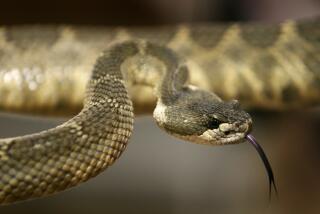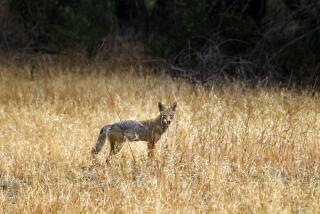Rattlesnake Roundups Offer Big Bite to Texans : Reptiles: Growing market for skins draws thousands to the events. Criticism from activists falls on deaf ears.
- Share via
SWEETWATER, Tex. — The rattlesnake did not want to come out of its den, but that hardly mattered. With a billow of gasoline fumes and the deft jerk of a comfortably long hook, Bill Ransberger fished it out anyway--a sluggish, undulating Western diamondback waking up in a bad temper to the West Texas sunshine.
As the saying goes, it’s roundup time in Texas, but not for the little dogies that populate the cattle ranches around this small town west of Abilene. Here, where the residents learn early to step cautiously through their back yards and pastures, and where the opinion still flourishes that the only good rattler is a dead rattler, there is no guilt about staging a weekend festival in celebration of snake snatching.
In its 37 years, the Sweetwater roundup, billed as the world’s largest, has consigned nearly 300,000 pounds of rattlers to their doom--or to eventual incarnations as cowboy boots, hatbands and fried “rattlesnack” meat.
“Now if I was a snake lover, I wouldn’t be out killing them, would I?” said Ransberger, 70, a master hunter who has been bitten 40 times (“Almost lost my right arm to the last one”) and the snake-handling guru at this Jaycee-sponsored charity event. “We are very serious about this, very safety-conscious. You don’t see anybody running around here with a rubber snake trying to goose people.”
No, but any of the 30,000 visitors at the town coliseum would see Jaycee Tommy Wood standing calmly in the snake pit, ankle deep in hundreds of live rattlers just brought in from the hunt. He wore chaps made of bullet-proof material and stirred the thick pile of snakes with a hook so they would not smother themselves, occasionally lifting one high for a better look.
Nearby, a gloveless Gene Hendrix milked a reptile of its venom, expertly squeezing the glands behind its jaw; a ring of spectators watched. Other Jaycees probed the snakes to determine their sex (about 60% are male), weighed them (most average about a pound and a quarter) and tallied up which hunters have had the greatest success (paid at a rate of $5 a pound for the first 2,000 pounds).
“Lord, I’m going to have nightmares about snakes tonight,” said Carolyn Wells of Nederland, Tex., as she shuddered and turned away from the pits. This was all her husband Gary’s big idea, she said, not hers.
Rattlesnake roundups do tend to assault the senses. The stench of snake urine hung in the air, undiminished by the frequent spritzes of spray deodorant by the Jaycees, and the sound of hundreds of rattlesnakes shaking their rattles was like an ancient battle cry that made the listener want to run for the nearest tree.
Organized roundups here and in other West and South Texas towns like Big Spring and Freer began more than 30 years ago, after ranchers complained that the plentiful rattlers were biting livestock and often causing cattle to produce deformed calves. In more recent years, as the rattlesnake has become popular as a skin, the roundups have become big moneymakers.
Animal-rights protesters began showing up at the roundups a few years ago, dressed in skeleton suits and decrying the harm done to the environment, but little attention was paid to their demonstrations.
“You don’t tell a Texan not to do something; that’s a sure-fire way to get him to do it,” Ransberger said.
The number of protesters has dwindled to a handful. But state wildlife officials admit the events have a politically incorrect tone and hope to use information gathered at them to help correct a data gap: No one has much information on the abundance and durability of the rattler.
“What little data we have indicates that rattlesnakes are not in any danger--they’re just like deer, able to survive a moderate harvest,” said John Herron of the Texas Parks and Wildlife Department. “We probably have well over 20 million rattlesnakes, and reports of 200,000 a year harvested--that’s only 1%. You figure more snakes get run over by trucks or eaten by hawks than killed by these guys running around with their gunnysacks for a couple of days.”
Herron describes the rattlesnake as “a perfectly evolved mouse-killing machine,” and says it is a shame so many people dislike them. Legislation to protect snakes and other non-game wildlife, such as bats and box turtles, has been bandied about, he said, but because of the lack of scientific data, “it’s hard to justify making any laws.”
Arizona--with 11 species of rattlesnake--is also the most protective of its creatures. It prohibits the hunting of four species and sets a bag limit of four snakes per day for the others, said Jeff Howland, a herpetologist with the Arizona Game and Fish Department. The sale of rattlesnake meat also is forbidden, and organized roundups are not staged.
But here in Texas, it’s a far different story, with the roundups ranging from the relatively sedate events like Sweetwater’s to carnival-like exhibitions, such as Taylor’s in recent years, where daredevils have been known to slide into sleeping bags along with waiting rattlers, said Clark E. Adams, a wildlife biologist at Texas A&M; University.
Adams, who attempted to measure the effect of the roundups in a 1991 state-commissioned study, said he did not detect “any up or down trend” in the snake population. But he continues to insist that the important issue is “not snake-hunting, but the fact that so few regulations are coming from the state.”
“The lack of public reaction to the issue, I’m sure, is related to the fact that reptiles are not a favorite species,” he said. “They’re not going to make you have those warm and fuzzy feelings.”
More to Read
Sign up for Essential California
The most important California stories and recommendations in your inbox every morning.
You may occasionally receive promotional content from the Los Angeles Times.













